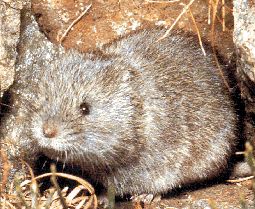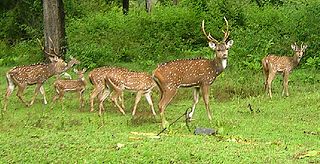
Microtus is a genus of voles found in North America, Europe and northern Asia. The genus name refers to the small ears of these animals. They are stout rodents with short ears, legs and tails. They eat green vegetation such as grasses and sedges in summer, and grains, seeds, root and bark at other times. The genus is also called "meadow voles".

Clethrionomys is a genus of small, slender voles. In recent years the genus name was changed to Myodes, however a 2019 paper found that Myodes was actually a junior synonym for Lemmus, thus making it unusable. As such, Clethrionomys is re-established as the proper genus name. At the same time, several species were moved to the genus Craseomys, so members of both genera are referred to as red-backed voles. This genus was described by Johannes von Nepomuk Franz Xaver Gistel under the pseudonym "G. Tilesius". Some authors cite the taxonomic authority as "Gistel, 1850", whereas others still use "Tilesius, 1850".

Water voles are large voles in the genus Arvicola. They are found in both aquatic and dry habitat through Europe and much of northern Asia. A water vole found in Western North America was historically considered a member of this genus, but has been shown to be more closely related to members of the genus Microtus. Head and body lengths are 12–22 cm, tail lengths are 6.5–12.5 cm, and their weights are 70–250 g. The animals may exhibit indeterminate growth. They are thick-furred and have hairy fringes on their feet that improve their swimming ability.

A leaf miner is any one of numerous species of insects in which the larval stage lives in, and eats, the leaf tissue of plants. The vast majority of leaf-mining insects are moths (Lepidoptera), sawflies, and flies (Diptera). Some beetles also exhibit this behavior.

Tenthredinidae is the largest family of sawflies, with well over 7,500 species worldwide, divided into 430 genera. Larvae are herbivores and typically feed on the foliage of trees and shrubs, with occasional exceptions that are leaf miners, stem borers, or gall makers. The larvae of externally feeding species resemble small caterpillars. As with all hymenopterans, common sawflies undergo complete metamorphosis.

Chionomys is a genus of rodent in the family Cricetidae.

Arvicolini is a tribe of voles in the subfamily Arvicolinae.

Nematinae is a subfamily of sawflies belonging to the family Tenthredinidae. It contains over 1250 described species in ~40 genera. Members of this subfamily feed on a wide range of plants and employ a wide range of feeding habits, both internally and externally, on their host plants.

Axis is a genus of deer occurring in South and Southeast Asia. As presently defined by most authorities, four species are placed in the genus. Three of the four species are called hog deer. The genus name is a word mentioned in Pliny the Elder's Natural History.

Tenthredininae is a subfamily of sawflies within the family Tenthredinidae, the largest sawfly family. It consists of 28 genera, including the type genus Tenthredo. It also includes most of the larger and more colourful members of the family.
Fenusa is a genus of common sawflies in the family Tenthredinidae. There are about 11 described species in Fenusa.
Pseudodineura is a genus of sawflies belonging to the family Tenthredinidae.

Selandria is a genus of sawflies belonging to the family Tenthredinidae.
Nematinus is a genus of sawflies belonging to the family Tenthredinidae.
Metallus is a genus of sawflies belonging to the family Tenthredinidae. The species of this genus are found in Europe and North America.

Dolerus is a genus of sawflies belonging to the family Tenthredinidae.
Dineura is a genus of sawflies belonging to the family Tenthredinidae.

Stromboceros is a genus of insects belonging to the family Tenthredinidae.
Harpiphorus is a genus of insects belonging to the family Tenthredinidae.












